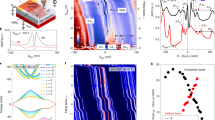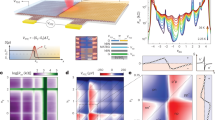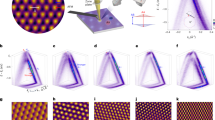Abstract
In systems with multiple energy bands, the interplay between electrons with different effective masses drives correlated phenomena that do not occur in single-band systems. Magic-angle twisted trilayer graphene is a tunable platform for exploring such effects, hosting both heavy electrons in its flat bands and delocalized light Dirac electrons in dispersive bands. Superconductivity in this system spans a wider range of phase space than moiré materials without dispersive bands, suggesting that interband interactions influence the stabilization of correlated phases. Here we investigate the interplay between the light and heavy electrons in magic-angle twisted trilayer graphene by performing local compressibility measurements with a scanning single-electron-transistor microscope. We establish that weak incompressibility features near several integer moiré band fillings host a finite population of light Dirac electrons at the Fermi level, despite a gap opening in the flat band sector. At higher magnetic field near charge neutrality, we find a phase transition sequence that is robust over nearly 10 μm but exhibits complex spatial dependence. Calculations establish that the Dirac sector can be viewed as flavour analogous to the spin and valley degrees of freedom.
This is a preview of subscription content, access via your institution
Access options
Access Nature and 54 other Nature Portfolio journals
Get Nature+, our best-value online-access subscription
$32.99 / 30 days
cancel any time
Subscribe to this journal
Receive 12 print issues and online access
$259.00 per year
only $21.58 per issue
Buy this article
- Purchase on SpringerLink
- Instant access to full article PDF
Prices may be subject to local taxes which are calculated during checkout




Similar content being viewed by others
Data availability
Source data are provided with this paper. All other data that support the findings of this Article are available from the corresponding authors upon request.
Code availability
The codes that support the findings of this study are available from the corresponding authors upon reasonable request.
References
Cao, Y. et al. Unconventional superconductivity in magic-angle graphene superlattices. Nature 556, 43–50 (2018).
Cao, Y. et al. Correlated insulator behaviour at half-filling in magic-angle graphene superlattices. Nature 556, 80–84 (2018).
Serlin, M. et al. Intrinsic quantized anomalous Hall effect in a moiré heterostructure. Science 367, 900–903 (2020).
Xie, Y. et al. Fractional Chern insulators in magic-angle twisted bilayer graphene. Nature 600, 439–443 (2021).
Xu, C. & Balents, L. Topological superconductivity in twisted multilayer graphene. Phys. Rev. Lett. 121, 087001 (2018).
Liu, C.-C., Zhang, L.-D., Chen, W.-Q. & Yang, F. Chiral spin density wave and d + id superconductivity in the magic-angle-twisted bilayer graphene. Phys. Rev. Lett. 121, 217001 (2018).
Kennes, D. M., Lischner, J. & Karrasch, C. Strong correlations and d + id superconductivity in twisted bilayer graphene. Phys. Rev. B 98, 241407 (2018).
Wu, F., MacDonald, A. H. & Martin, I. Theory of phonon-mediated superconductivity in twisted bilayer graphene. Phys. Rev. Lett. 121, 257001 (2018).
Isobe, H., Yuan, N. F. Q. & Fu, L. Unconventional superconductivity and density waves in twisted bilayer graphene. Phys. Rev. X 8, 041041 (2018).
Lian, B., Wang, Z. & Bernevig, B. A. Twisted bilayer graphene: a phonon-driven superconductor. Phys. Rev. Lett. 122, 257002 (2019).
Park, J. M., Cao, Y., Watanabe, K., Taniguchi, T. & Jarillo-Herrero, P. Tunable strongly coupled superconductivity in magic-angle twisted trilayer graphene. Nature 590, 249–255 (2021).
Hao, Z. et al. Electric field–tunable superconductivity in alternating-twist magic-angle trilayer graphene. Science 371, 1133–1138 (2021).
Khalaf, E., Kruchkov, A. J., Tarnopolsky, G. & Vishwanath, A. Magic angle hierarchy in twisted graphene multilayers. Phys. Rev. B 100, 085109 (2019).
Park, J. M. et al. Robust superconductivity in magic-angle multilayer graphene family. Nat. Mater. 21, 877–883 (2022).
Zhang, Y. et al. Promotion of superconductivity in magic-angle graphene multilayers. Science 377, 1538–1543 (2022).
Burg, G. W. et al. Emergence of correlations in alternating twist quadrilayer graphene. Nat. Mater. 21, 884–889 (2022).
Ramires, A. & Lado, J. L. Emulating heavy fermions in twisted trilayer graphene. Phys. Rev. Lett. 127, 026401 (2021).
Yu, J., Xie, M., Bernevig, B. A. & Das Sarma, S. Magic-angle twisted symmetric trilayer graphene as a topological heavy-fermion problem. Phys. Rev. B 108, 035129 (2023).
Song, Z.-D. & Bernevig, B. A. Magic-angle twisted bilayer graphene as a topological heavy fermion problem. Phys. Rev. Lett. 129, 047601 (2022).
Chou, Y.-Z. & Das Sarma, S. Kondo lattice model in magic-angle twisted bilayer graphene. Phys. Rev. Lett. 131, 026501 (2023).
Zhou, G.-D., Wang, Y.-J., Tong, N. & Song, Z.-D. Kondo phase in twisted bilayer graphene. Phys. Rev. B 109, 045419 (2024).
Hu, H., Bernevig, B. A. & Tsvelik, A. M. Kondo lattice model of magic-angle twisted-bilayer graphene: Hund’s rule, local-moment fluctuations, and low-energy effective theory. Phys. Rev. Lett. 131, 026502 (2023).
Hu, H. et al. Symmetric Kondo lattice states in doped strained twisted bilayer graphene. Phys. Rev. Lett. 131, 166501 (2023).
Cao, Y., Park, J. M., Watanabe, K., Taniguchi, T. & Jarillo-Herrero, P. Pauli-limit violation and re-entrant superconductivity in moiré graphene. Nature 595, 526–531 (2021).
Liu, X., Zhang, N. J., Watanabe, K., Taniguchi, T. & Li, J. I. A. Isospin order in superconducting magic-angle twisted trilayer graphene. Nat. Phys. 18, 522–527 (2022).
Kim, H. et al. Evidence for unconventional superconductivity in twisted trilayer graphene. Nature 606, 494–500 (2022).
Shen, C. et al. Dirac spectroscopy of strongly correlated phases in twisted trilayer graphene. Nat. Mater. 22, 316–321 (2023).
Martin, J., Feldman, B. E., Weitz, R. T., Allen, M. T. & Yacoby, A. Local compressibility measurements of correlated states in suspended bilayer graphene. Phys. Rev. Lett. 105, 256806 (2010).
Streda, P. Theory of quantised Hall conductivity in two dimensions. J. Phys. C 15, L717–L721 (1982).
Pierce, A. T. et al. Unconventional sequence of correlated Chern insulators in magic-angle twisted bilayer graphene. Nat. Phys. 17, 1210–1215 (2021).
Yu, J. et al. Correlated Hofstadter spectrum and flavour phase diagram in magic-angle twisted bilayer graphene. Nat. Phys. 18, 825–831 (2022).
Ilani, S. et al. The microscopic nature of localization in the quantum Hall effect. Nature 427, 328–332 (2004).
Martin, J. et al. Localization of fractionally charged quasi-particles. Science 305, 980–983 (2004).
Turkel, S. et al. Orderly disorder in magic-angle twisted trilayer graphene. Science 376, 193–199 (2022).
Xie, Y. et al. Strong interactions and isospin symmetry breaking in a supermoiré lattice. Preprint at https://arxiv.org/abs/2404.01372 (2024).
Feldman, B. E. et al. Fractional quantum hall phase transitions and four-flux states in graphene. Phys. Rev. Lett. 111, 076802 (2013).
Taychatanapat, T., Watanabe, K., Taniguchi, T. & Jarillo-Herrero, P. Quantum Hall effect and Landau-level crossing of Dirac fermions in trilayer graphene. Nat. Phys. 7, 621–625 (2011).
Datta, B. et al. Strong electronic interaction and multiple quantum Hall ferromagnetic phases in trilayer graphene. Nat. Commun. 8, 14518 (2017).
Zondiner, U. et al. Cascade of phase transitions and Dirac revivals in magic-angle graphene. Nature 582, 203–208 (2020).
Park, J. M., Cao, Y., Watanabe, K., Taniguchi, T. & Jarillo-Herrero, P. Flavour Hund’s coupling, Chern gaps and charge diffusivity in moiré graphene. Nature 592, 43–48 (2021).
Wang, L. et al. One-dimensional electrical contact to a two-dimensional material. Science 342, 614–617 (2013).
Acknowledgements
We acknowledge discussions with A. Stern. We thank A. Vishwanath, E. Khalaf, D. Parker, P. Ledwith and J. Wang for collaboration on related projects. This work was sponsored by the Army Research Office under award number W911NF-21-2-0147 and by the Gordon and Betty Moore Foundation EPiQS initiative through Grant GBMF 9468. Help with transport measurements and data analysis were supported by the National Science Foundation (DMR-1809802), and the STC Center for Integrated Quantum Materials (NSF grant number DMR-1231319). P.J.-H. acknowledges support from the Gordon and Betty Moore Foundation’s EPiQS Initiative through Grant GBMF9463, the CIFAR Quantum Materials Program and the Fundación Ramón Areces. A.T.P. acknowledges support from the Department of Defense through the National Defense Science and Engineering Graduate Fellowship (NDSEG) Program. Y.X. acknowledges partial support from the Harvard Quantum Initiative in Science and Engineering. During the revision of this work, Y.X. was supported by the NSF CAREER DMR-2339623 and Robert A. Welch Foundation grant number C-2219 and A.Y. was partly supported by the Gordon and Betty Moore Foundation through Grant GBMF12762. Y.X, A.T.P. and A.Y. acknowledge support from the Harvard Quantum Initiative Seed Fund. K.W. and T.T. acknowledge support from the JSPS KAKENHI (grant numbers 21H05233 and 23H02052), the CREST (grant number JPMJCR24A5), JST and World Premier International Research Center Initiative (WPI), MEXT, Japan. This work was performed, in part, at the Center for Nanoscale Systems (CNS), a member of the National Nanotechnology Infrastructure Network, which is supported by the NSF under award number ECS-0335765. CNS is part of Harvard University.
Author information
Authors and Affiliations
Contributions
A.T.P., Y.X., J.M.P., P.J.-H. and A.Y. designed the experiment. A.T.P., Y.X. and Z.C. performed the scanning SET experiment and the temperature-dependent transport measurements and analysed the data with input from A.Y. J.M.P. and P.J.-H. designed and provided the samples and contributed to the analysis of the results. Y.X., A.T.P. and Z.C. carried out the simulation of the compressibility. K.W. and T.T. provided hBN crystals. All authors participated in discussions and in writing of the paper.
Corresponding authors
Ethics declarations
Competing interests
The authors declare no competing interests.
Peer review
Peer review information
Nature Physics thanks Abhay Pasupathy and the other, anonymous, reviewer(s) for their contribution to the peer review of this work.
Additional information
Publisher’s note Springer Nature remains neutral with regard to jurisdictional claims in published maps and institutional affiliations.
Extended data
Extended Data Fig. 1 Device and transport characterization.
a, Left panel: Optical microscope image of the device. The black points marked 1 (1.53°) and 2 (1.58°) are the approximate locations at which the compressibility measurements were carried out. Vxx denotes contacts used for the transport measurements. Right panel: topographic image obtained by measuring the electrostatic potential of the device using the scanning SET. b, Temperature-dependent longitudinal resistance Rxx measured between contacts marked by Vxx in a, showing superconductivity for both electron and hole dopings.
Extended Data Fig. 2 Experimentally determined Hofstadter energy spectrum obtained from a second location.
The location is marked 2 in Extended Data Fig 1 and the local twist angle θ is around 1.58°. Orange and blue dots correspond to contributions from the Dirac and flat bands, respectively.
Extended Data Fig. 3 Negligible role of quantum capacitance on the density shifts.
a-d, Locations of the incompressibility peaks as a function of the magnetic field (blue circles) and the corresponding linear fit (red line) at integer fillings. e-h, Fit residual from a-d, demonstrating a universal finite density shift near zero magnetic field. i-l, Change of chemical potentials associated with the incompressible peaks at integer fillings as a function of magnetic field.
Extended Data Fig. 4 Spatial dependence of localized states at different tip-sample voltages.
a-c, Position-dependent of the localized states associated with the (C, ν) = (2, −2) Chern insulators at 2T measured with three different tip-sample voltages Vt-s = +1.35V (a), +0.45V (b) and −0.65V (c). The insets sketch the density profiles observed in the data, demonstrating their tunability by Vt-s. The density modulation used is about δn~5.7x108 cm−2.
Extended Data Fig. 5 Simulation results from a non-interacting phenomenological model.
a, Inverse compressibility as a function of Landau level fillings and magnetic fields, computed from the linearly-dispersive energy spectrum shown in Fig. 3b. b, The corresponding energy gaps from the same calculation as (a) and their comparison with the experiments. Despite its simplicity, our non-interacting phenomelogical model not only captures the locations at which integer quantum Hall states are interrupted, but also produces gap values in close agreement with the experiment.
Extended Data Fig. 6 Role of Coulomb interaction in driving the phase transition near the CNP.
a-c, Simulated inverse compressibility using the mean-field model described in the text (see also Methods section) at three representative U/W values.
Extended Data Fig. 7 Phase transitions near charge neutrality measured at a second location.
a, Local compressibility of MATTG in the vicinity of charge neutrality plotted as a function of Landau level filling factor νLL and magnetic field. b, Simulated inverse compressibility using the mean-field model described in the text (see also Methods section). nD represents the number of Landau levels that are partially or fully populated with carriers.
Source data
Source Data Fig. 1
Source data for Fig. 1b,e.
Source Data Fig. 2
Source data for Fig. 2a–k.
Source Data Fig. 3
Source data for Fig. 3a,b.
Source Data Fig. 4
Source data for Fig. 4a–c.
Source Data Extended Data Fig. 1
Source data for Extended Data Fig. 1b.
Source Data Extended Data Fig. 2
Source data for Extended Data Fig. 2.
Source Data Extended Data Fig. 3
Source data for Extended Data Fig. 3a–l.
Source Data Extended Data Fig. 4
Source data for Extended Data Fig. 4a–c.
Source Data Extended Data Fig. 5
Source data for Extended Data Fig. 5a,b.
Source Data Extended Data Fig. 6
Source data for Extended Data Fig. 6a–c.
Source Data Extended Data Fig. 7
Source data for Extended Data Fig. 7a,b.
Rights and permissions
Springer Nature or its licensor (e.g. a society or other partner) holds exclusive rights to this article under a publishing agreement with the author(s) or other rightsholder(s); author self-archiving of the accepted manuscript version of this article is solely governed by the terms of such publishing agreement and applicable law.
About this article
Cite this article
Pierce, A.T., Xie, Y., Park, J.M. et al. Tunable interplay between light and heavy electrons in twisted trilayer graphene. Nat. Phys. 21, 1237–1242 (2025). https://doi.org/10.1038/s41567-025-02956-z
Received:
Accepted:
Published:
Issue date:
DOI: https://doi.org/10.1038/s41567-025-02956-z



